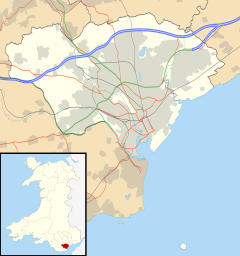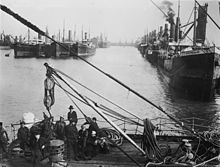
Cardiff is the capital and largest city of Wales. Cardiff had a population of 362,310 in 2021, forms a principal area officially known as the City and County of Cardiff, and the city is the eleventh-largest in the United Kingdom. Located in the south-east of Wales and in the Cardiff Capital Region, Cardiff is the county town of the historic county of Glamorgan and in 1974–1996 of South Glamorgan. It belongs to the Eurocities network of the largest European cities. A small town until the early 19th century, its prominence as a port for coal when mining began in the region helped its expansion. In 1905, it was ranked as a city and in 1955 proclaimed capital of Wales. Cardiff Built-up Area covers a larger area outside the county boundary, including the towns of Dinas Powys and Penarth.


Cardiff Bay is an area and freshwater lake in Cardiff, Wales. The site of a former tidal bay and estuary, it is the river mouth of the River Taff and Ely. The body of water was converted into a 500-acre (2.0 km2) lake as part of a UK Government redevelopment project, involving the damming of the rivers by the Cardiff Bay Barrage in 1999. The barrage impounds the rivers from the Severn Estuary, providing flood defence and the creation of a permanent non-tidal high water lake with limited access to the sea, serving as a core feature of the redevelopment of the area in the 1990s.

Penarth is a town and community in the Vale of Glamorgan, Wales, approximately 3 miles (4.8 km) south of Cardiff city centre on the west shore of the Severn Estuary at the southern end of Cardiff Bay.

The Butetown branch line, also known as the Cardiff Bay Line, is a 1-mile-6-chain (1.7 km) commuter railway line in Cardiff, Wales from Cardiff Bay to Cardiff Queen Street. The service pattern used to comprise a mixture of shuttle services along the branch and through trains along the Rhymney Line to Caerphilly, or the Coryton Line to Coryton, but since December 2005 is a shuttle service from Queen Street station. The normal journey time is four minutes.

Cardiff Bay railway station, formerly Cardiff Bute Road, is a station serving the Cardiff Bay and Butetown areas of Cardiff, Wales. It is the southern terminus of the Butetown branch line 1 mile (1.5 km) south of Cardiff Queen Street.

St David's Hall is a performing arts and conference venue in the heart of Cardiff, Wales.

The Senedd building in Cardiff houses the debating chamber and three committee rooms of the Senedd. The 5,308-square-metre (57,100 sq ft) Senedd building was opened by Queen Elizabeth II on 1 March 2006, Saint David's Day, and the total cost was £69.6 million, which included £49.7 million in construction costs. The Senedd building is part of the Senedd estate that includes Tŷ Hywel and the Pierhead Building.

Bute Street is a street in Cardiff, Wales. It links Cardiff Bay and Butetown with Cardiff city centre. It now has no road number. It runs from the dockside of the Mermaid Quay complex in the south, which is now a pedestrian zone, to the junction of Bute Terrace (A4160) in the north.

Edwin Seward (1853–1924) was an architect based in Cardiff, Wales.

The timeline of Cardiff history shows the significant events in the history of Cardiff which transformed it from a small Roman fort into the modern capital city of Wales.
As the capital city of Wales, Cardiff is the main engine of growth in the Welsh economy; the city has been developing as a significant service centre and economic driver for the wider south east Wales economy. The city and the adjoining Vale of Glamorgan contribute a disproportionately high share of economic output in Wales. The Cardiff travel to work area has grown significantly since 1991; the 2001-based version includes much of the central South Wales Valleys in addition to the Vale of Glamorgan.

Cardiff Docks is a port in southern Cardiff, Wales. At its peak, the port was one of the largest dock systems in the world with a total quayage of almost 7 mi (11 km). Once the main port for the export of South Wales coal, the Port of Cardiff remains active in the import and export of containers, steel, forest products and dry and liquid bulks.

Architecture in Cardiff, the capital city of Wales, dates from Norman times to the present day. Its urban fabric is largely Victorian and later, reflecting Cardiff's rise to prosperity as a major coal port in the 19th century. No single building style is associated with Cardiff, but the city centre retains several 19th and early 20th century shopping arcades.

Insole Court is a Grade II* Listed Victorian Gothic mansion in Llandaff, Cardiff, Wales, built for wealthy businessman James Harvey Insole and dating back to 1855.

Rainhill Hall or Loyola Hall is a Grade II listed country house built in the 19th century in Rainhill, Merseyside, England, by Bartholomew Bretherton. It is situated on the Warrington Road, next to St Bartholomew's Church. From 1923 to 2014, it was a retreat house run by the Society of Jesus. From 2017, it has been a hotel and wedding venue owned by Signature Living.

Butetown History & Arts Centre (BHAC) was a historical archive, educational centre and art gallery located in the Butetown area of Cardiff, Wales. BHAC was founded by Glenn Jordan as a non-profiting organisation with the aim to involve the local people of Butetown to help promote the area's history of the docklands.

Mount Stuart Square is a residential and commercial square in Cardiff, Wales. It is located in the Butetown area of the city. Originally developed in the late 1800s as a residential location for nearby dock workers, it quickly became a centre for upscale residential properties which revolved around the main square. By 1900, commercial activity had taken its place, dominated by the Coal Exchange, which occupied the once open central space. The square contains a high concentration of listed buildings, which represent a range of architectural styles and some of Cardiff's finest examples of late 19th and early 20th century commercial architecture. Mount Stuart Square area was designated a Conservation Area in July 1980.






















